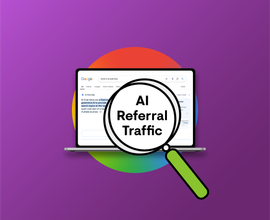The KPIs to Measure SEO Success
Find out which SEO KPIs to track so you can identify which pages of your website and aspects of your brand messaging are working and what to improve upon.
Measuring and reporting on the results of your SEO efforts is vital. But what key performance indicators(KPIs) should you be measuring to understand the impact of those efforts? It's easy to get distracted with details that don't matter in the grand scheme of things.
When you're spending significant time and money on your initiatives, you need to know what it gets you. Without that information, you're in the dark and will end up wasting resources on the wrong things. In this article, we'll review what KPIs matter when measuring SEO success. Put this knowledge to use to be more successful in your SEO initiatives, build better KPI reports, and help you get approval for new budgets.
SEO brings you money by driving relevant traffic to the site it helps promote. That traffic comes from rankingsRankings
Rankings in SEO refers to a website’s position in the search engine results page.
Learn more, and those rankings stem from backlinksBacklinks
Backlinks are links from outside domains that point to pages on your domain; essentially linking back from their domain to yours.
Learn more and the content and shape of the website from a technical standpoint.
What are KPIs in SEO?
KPIs are metrics that businesses and teams use to measure success. Basically, KPIs tell you whether the work and initiatives you’re focused on are driving the results you expected. There are KPIs that affect an entire company, like revenue metrics, and there are also KPIs that only certain individuals or teams drive towards in their day-to-day. For example, organic traffic is a KPI for SEOs and content marketers, but not something that a salesperson or customer success manager would care about. Let’s dive into some of the other key metrics that SEOs should pay attention to.
Segmentation
Before we continue, it's important to note that you need to segment KPIs.
Break down the KPIs discussed in this article using the following dimensions, as results can differ hugely between these dimensions, and breaking all of it down gives you additional insights:
- Website sections or landing pages
- Devices (desktop, tablet, or mobile)
- Location
- Search engine
Unless you're running brand campaigns, leave out the branded traffic when reporting SEO success. In almost every case, a website automatically ranks for its brand name, so it's not useful to include branded traffic in the KPIs.
KPIs to track for SEO
Below, we’ll get into the key metrics and KPIs SEOs should be reporting on to measure your success as a team and as a business.
1. Revenue + ROI and conversions
The number one metric to consider in your SEO KPI reporting is revenue and ROI:
- How much money was made
- What investment was made
- What the ROI is
Example: if you made $50,000 in revenue on a $10,000 investment, your ROI is: ($50,000 – $10,000) / $10,000 = 400%
People with a business background often don't care about rankings—they want to know how much money was made. Rightfully so! Thus, this is the number one KPI to report on.
Getting your hands on revenue data can prove difficult. It's easy for an eCommerce site, but if you're generating leads that need to be converted by a sales team, then it's harder. You may be able to feed back revenue data into your web analytics suite, but if not, you’ll need to compile this data later on after the sale is made—provided your client is OK with revealing that data.
A note about conversions
We’ll discuss conversions a bit more in-depth below, but reporting on conversions can be helpful if you can’t access revenue data. However, reporting on conversions has a downside: it doesn’t reflect the actual ROI of an investment. You can try attributing an average value to conversions or taking into account the quality of the leads, but ideally, you base it on real data.
2. Traffic: Sessions and their behavior
SEO is all about driving relevant traffic to a website. When it comes to this traffic, you need to report on the number of sessions and their characteristics. While these numbers won’t be as impactful for a business-minded leader as ROI metrics, they add context to those ROI numbers and help you understand which of your initiatives are worth the investment.
Study the visitors you've reached. Each one is a (potential) lead and can reveal key information on how your strategies are working. For example, understanding what piece of content brought in a new user can help you decide what initiatives to focus on. Keep a watchful eye on them and on the soft goals they've completed on your website. By "soft goals," we mean goals such as trial accounts created and newsletter sign-ups.
These are the KPIs to report on:
- Sessions (both new and returning visitors)
- Soft goals completed
- Assisted conversions
- Conversion rate for soft goal
Use these KPIs to improve visitors' engagement so that they ultimately complete more goals. If you do this, you need to ensure users stay on the website. Do this, for instance, by showing related pages in the content your visitors are reading or by implementing eternal scrolling.
3. Keyword rankings
For a long time, rankings in search engines were the most important KPI to report on for SEO. But rankings in search engines alone only tell part of the story because you could have #1 rankings for search queries that are driving a lot of traffic that doesn't convert.
That's why looking at how traffic and behavior impact revenue is so important. Having said that, rankings are important when measuring SEO success because they help you understand why traffic is rising or falling. SEO platforms, like Conductor, offer daily keyword rank tracking so you can see search engineSearch Engine
A search engine is a website through which users can search internet content.
Learn more positions for various keywords in real-time.
Often, the same page or pages within the same website section rank for related search queries, and therefore, group the search queries together and report on a group of search queries rather than on each individually. Here's an example of keywords that may be ranking for a product category page with Nike shoes:
- Nike shoes
- Nike sneakers
- Nike shoes 2023
- Nike sneakers 2023
Reporting on these metrics gives meaning to the groups of search queries:
- Search queries at position #1
- Search queries in the top 5
- Search queries in the top 10
- Search queries outside of the top 50
- The average position of search queries
It's important to know whether SERP contains results like images, videos, rich snippetsRich Snippets
Special result snippets in Google search results are described as rich snippets.
Learn more, and Google MapsGoogle Maps
Google Maps is one of, if not the biggest, readily accessible and free online map services in the world.
Learn more listings, as these influence the chances of you achieving high rankings and/or noteworthy traffic through these search queries. Instead, you may want to focus on search queries without these features.
Market share
Understanding where your site and content appear on SERPs also clues you in to whom you’re competing against and where those competitors rank. You can use this information to get a sense of your market share for a particular keywordKeyword
A keyword is what users write into a search engine when they want to find something specific.
Learn more. Once you see what your competitors are doing to drive organic traffic, you can apply their best practices and strategies to improve your own content and rankings.
You can run reports to see market share data for your high-value keywords using Conductor's Market Share feature. These reports give you insight into:
- The real estate your content has earned in the top 10 results on SERPs
- New SEO competitors that might not be your traditional business competitors
- Backlinking opportunities from sites that rank well for a query
Use market share data to understand how fierce the competitionCompetition
Businesses generally know who their competitors are on the open market. But are they the same companies you need to fight to get the best placement for your website? Not necessarily!
Learn more is to rank for a particular query. If competition is high, it may not be worth the time and financial investment to try and rank for that keyword going forward. Consider focusing on keywords and queries that will be the best bang for your buck.
4. Operational SEO KPI
When it comes to operational SEO KPIs measuring SEO success, here's what you need to keep track of:
- Visibility in organic search results
- Website health
- Crawl efficiency
- Backlinks
Visibility in organic search results
Your visibility in organic search results is your market share within SEO. Each search query has a monthly search volumeSearch Volume
Search volume refers to the number of search queries for a specific keyword in search engines such as Google.
Learn more, and if you know the position of your website for that search query, you can calculate the estimated visitors you can expect.
There are numerous platforms, like Conductor, that calculate this automatically. If you use multiple resources to calculate your traffic and rankings, refrain from comparing the visibility scores from one platform to another. That's like comparing apples and oranges.
Don't have access to a tool like this? Then, you could do it manually as well, using, for instance, AWR's click-through data .
Website health
Your website's health is an important KPI. Website health comprises search engine accessibility (the technical side of things) and on-page optimization (all content search engine processes). Applications such as ContentKing for Conductor monitor the health of websites and alert you in cases of trouble. They mimic search engine behavior and evaluate the health of your website. Among other things, these issues need to be taken into account when evaluating website health:
- Meta information (Title and Meta description)
- Headings
- Broken links
- Duplicate content
- Canonicalization
- XML sitemap integrity
- Robots.txt

Crawl efficiency
It's important that search engines crawl your website efficiently—that search engines spend most of their attention for your website (a concept called crawl budget) on crawling pages that you want to appear in the search results rather than non-indexable pages, redirects, 404s, and so on.
The metrics to look out for are:
- The number of pages you want to get indexed and the number of pages actually indexed
- Number of pages crawled
- Avg. page load time (the lower, the better, ideally below one second)
As we covered in our Core Web Vitals Guide, search engines like Google use page speed to determine search results. A slow site could keep you out of the top rankings. These metrics are shown in Google Search ConsoleGoogle Search Console
The Google Search Console is a free web analysis tool offered by Google.
Learn more and Bing Webmaster Tools.
Backlinks
A backlink is a link from one page on a website to another. Each link passes on value, contributing to the value of the page that's linked. The sheer amount of links could be more interesting because having 1,000,000 links from one website to another adds little more value than, for instance, 10.
Two things are interesting—and they correlate with high rankings in search results:
- The number of referring domains.
- A domain's authority. Note that this could be called something different and be calculated differently by different platforms and tools.
Conclusion
Tracking the success of your SEO efforts is important, but be sure to focus on the right KPIs . KPIs like revenue metrics, organic traffic, and rankings help you understand what kind of impact you’re getting from your investments. If you don’t understand this, you risk spending your time, money, and resources on the wrong projects. In other words, if you don’t employ KPIs to measure your SEO success, you can’t know if you’re getting the most for your dollar.







